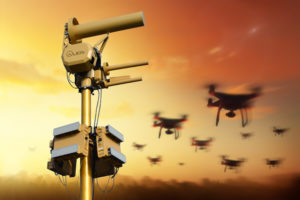
Anti-UAV Defense System recently announced new upgrades to its hardware allowing the solution to “more effectively defeat swarm attacks by malicious unmanned aircraft systems (UAS), including long-range winged drones,” according to a company press release.
The British consortium includes Blighter Surveillance Systems, Chess Dynamics and Enterprise Control Systems, a group that was chosen last year by the FAA to join its drone defense program in a partnership with American company Liteye Systems.
“We are committed to evolving the AUDS platform to meet the needs of military and security forces as they respond to the growing threat of malicious and errant UAVs,” Chess Systems CEO Graham Beall said. “These latest enhancements will consolidate our position as one the leading providers of a fully integrated strategic non-kinetic electronic [anti-drone] system.”
AUDS is a single-user solution with an intuitive interface and can detect, track, identify and defeat a drone in approximately 15 seconds at a range of up to 6 miles. With recent upgrades, AUDS can be deployed as a rapid “on-the-pause” anti-drone platform to stop rogue UAVs from attacking a temporary base, mobile force, convoy or major infrastructure facility. By making the system more rugged, AUDS offers users the option of loading it easily on to a vehicle such as a “Mercedes-Benz Sprinter-style van, as well as on semi-portable containers.”
AUDS now ships in three configurations – portable/rooftop, rugged field-mast and a fixed ground system.
“We have continued to refine our advanced RF inhibition capabilities to meet identified changes in the threat, enabling additional attributes designed to engage with some of the longer range fixed winged drones that have appeared over the last 12 months,” said Colin Bullock, CEO of Enterprise Control Systems.
“Our specialist RF engineers have also further fine-tuned some advanced techniques to even more effectively defeat coordinated, multi-drone swarm attacks made up of mixed drone types approaching in complex mission scenarios.”
A report released earlier this year predicted the anti-drone market will grow to $1.85 billion by 2024. As drone use grows, many public agencies and companies are seeking anti-drone solutions to stop drones from flying over restricted or unsafe locations such as wildfire zones, nuclear power plants, prisons and airports.
Jason is a longstanding contributor to DroneLife with an avid interest in all things tech. He focuses on anti-drone technologies and the public safety sector; police, fire, and search and rescue.
Beginning his career as a journalist in 1996, Jason has since written and edited thousands of engaging news articles, blog posts, press releases and online content.
Email Jason
TWITTER:@JasonPReagan
Subscribe to DroneLife here.